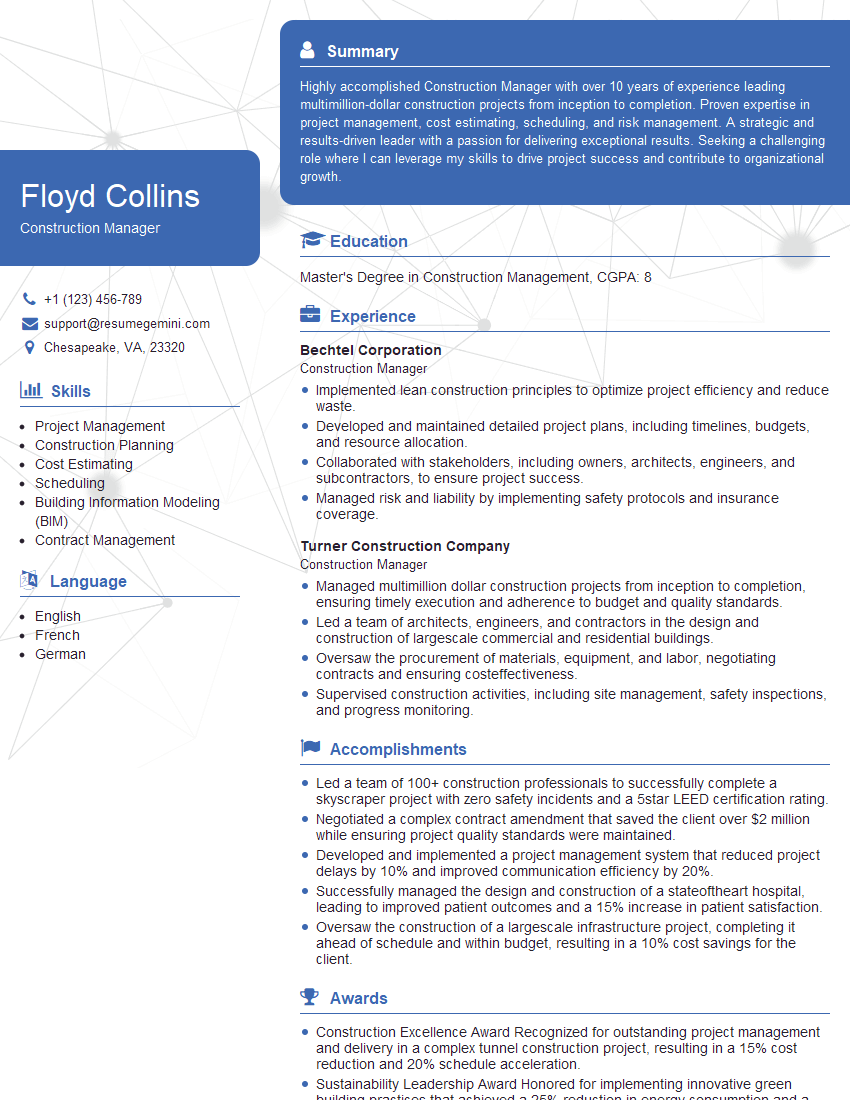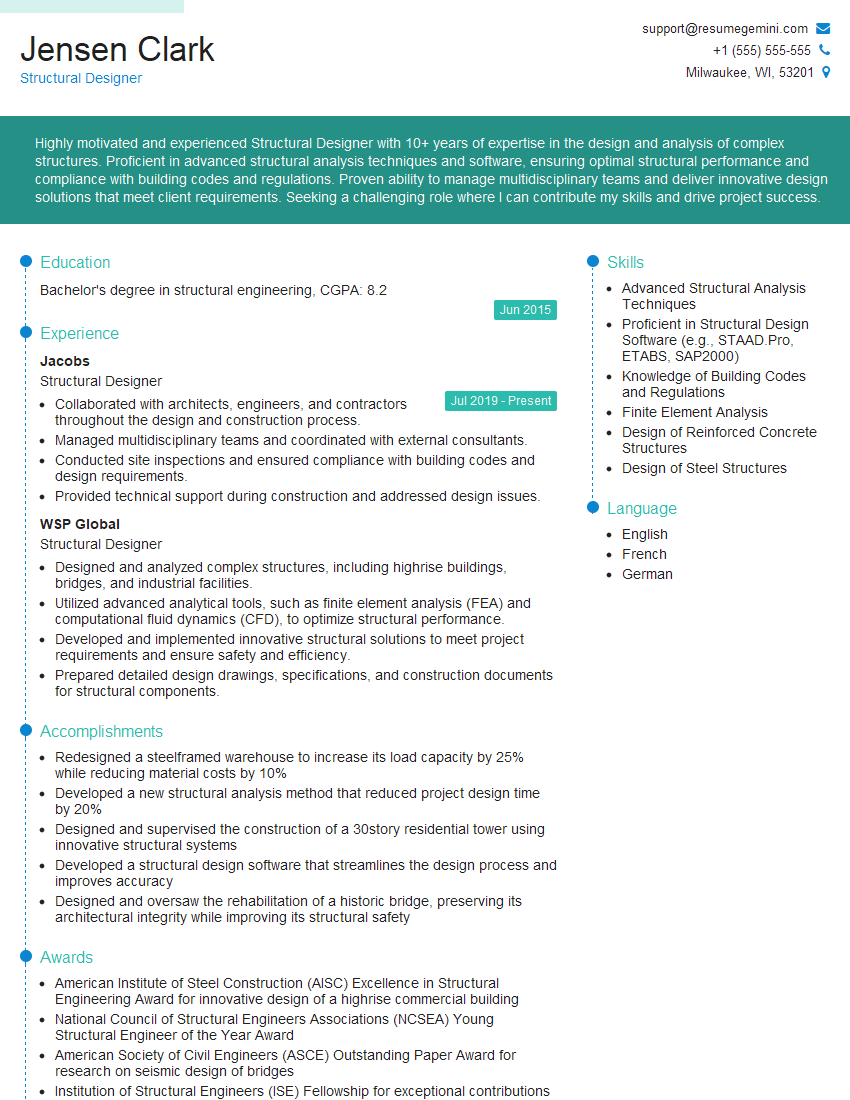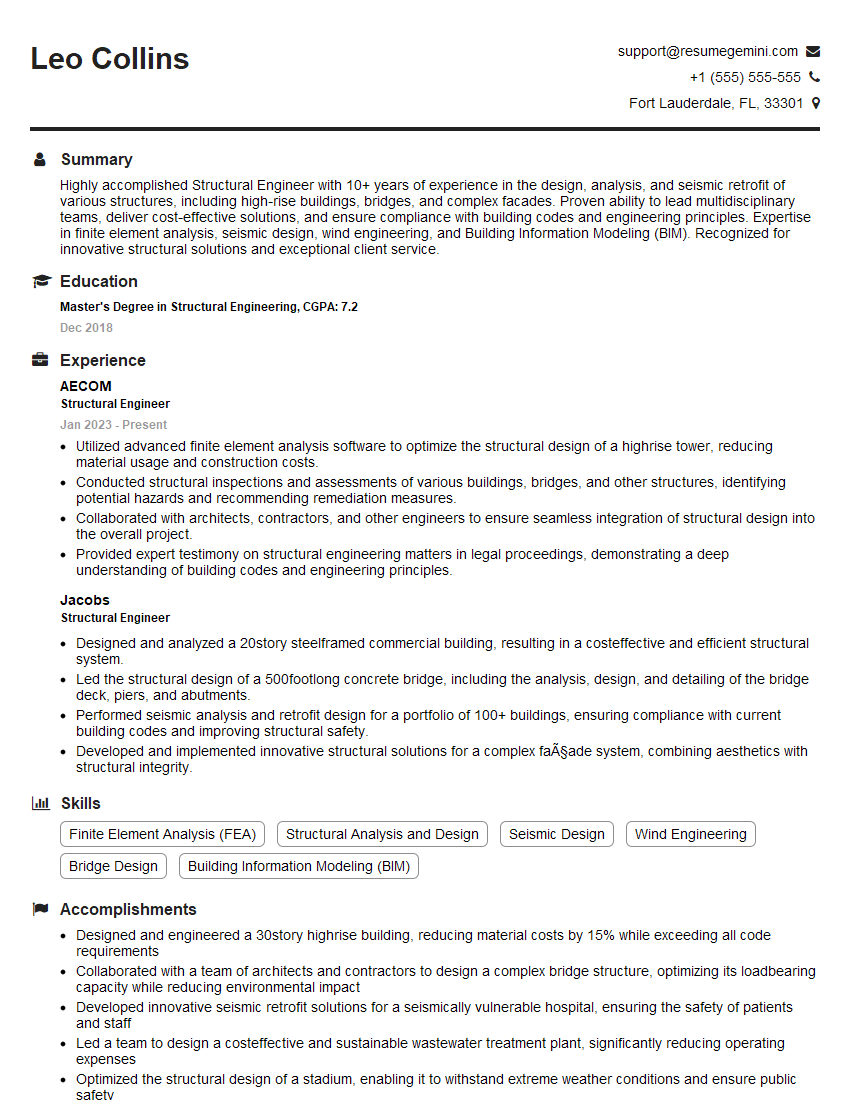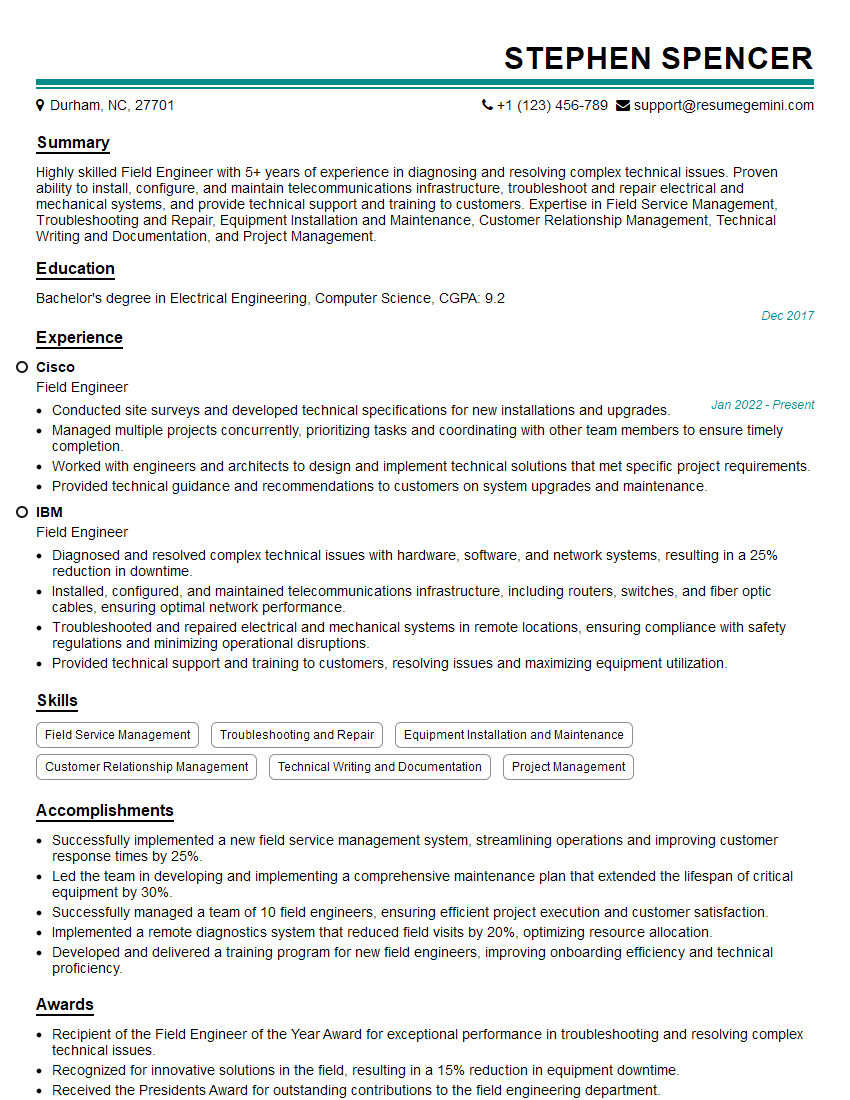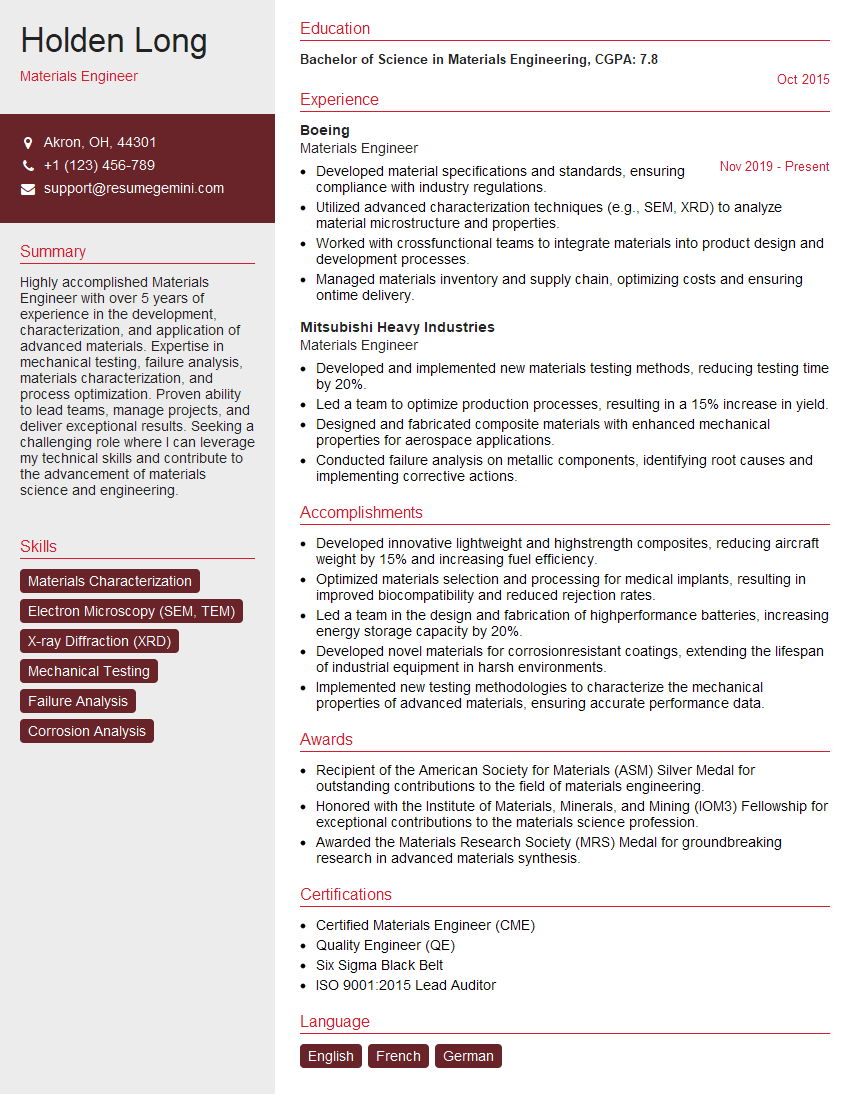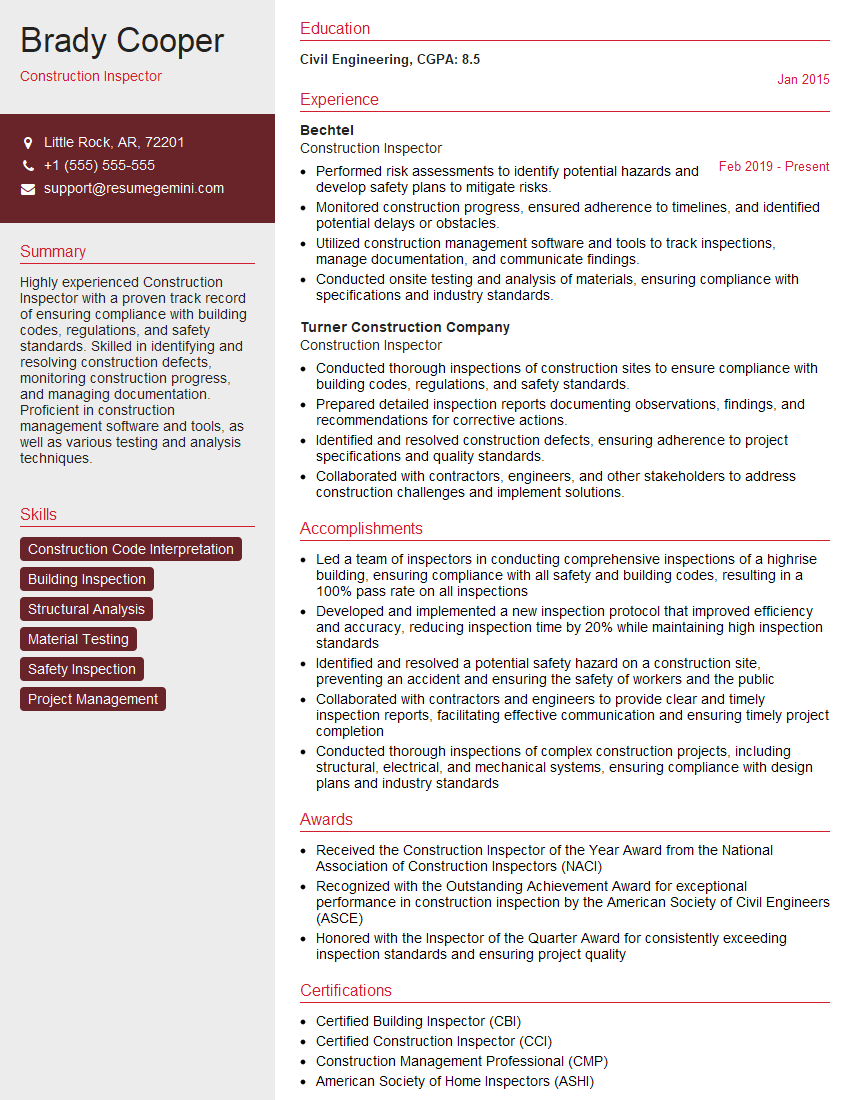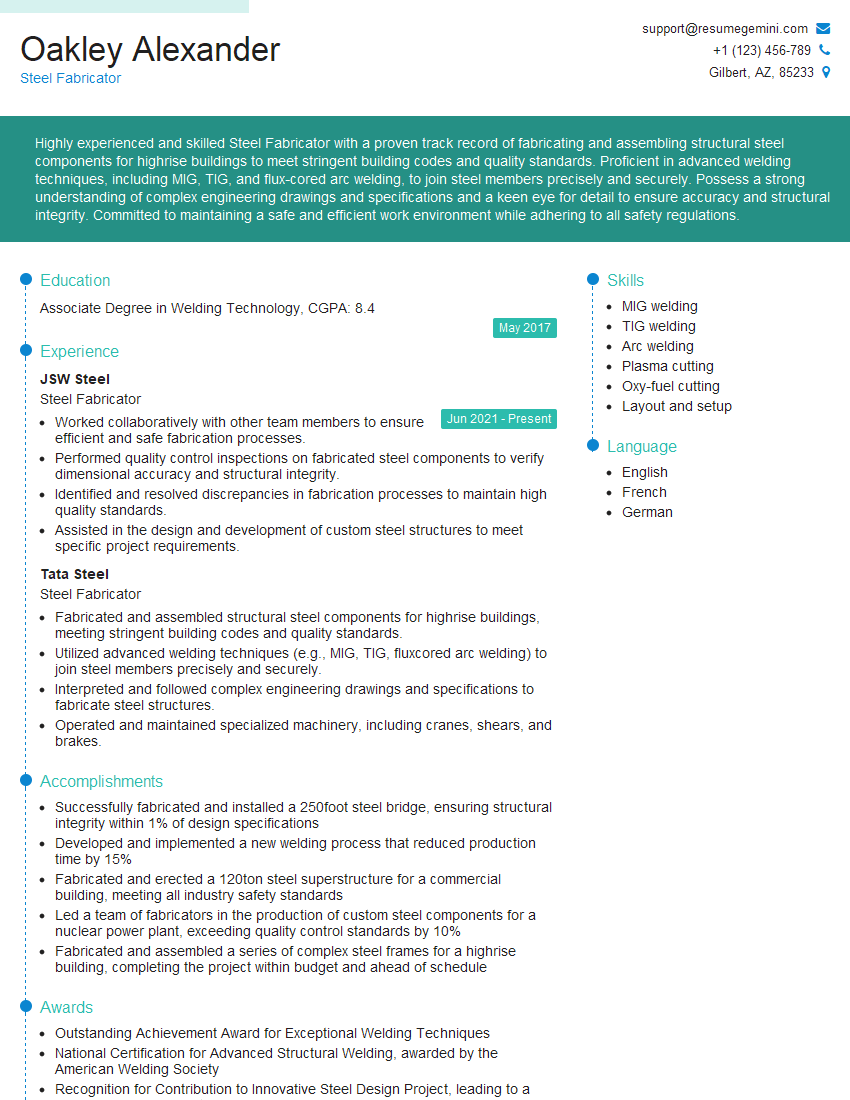Are you ready to stand out in your next interview? Understanding and preparing for Rebar Grade 80 interview questions is a game-changer. In this blog, we’ve compiled key questions and expert advice to help you showcase your skills with confidence and precision. Let’s get started on your journey to acing the interview.
Questions Asked in Rebar Grade 80 Interview
Q 1. What are the key mechanical properties of Grade 80 rebar?
Grade 80 rebar boasts superior strength compared to lower grades. Its key mechanical properties are defined by its high tensile strength (typically 80,000 psi), yield strength (around 75,000 psi), and excellent ductility. These properties allow for the use of smaller diameter bars in reinforced concrete structures, leading to cost savings and improved design flexibility. The high yield strength means the rebar can withstand significant stress before yielding (permanently deforming), crucial for structural integrity under load.
- Tensile Strength: The maximum stress a material can withstand before breaking. Think of it like the ultimate breaking point.
- Yield Strength: The stress at which the material begins to deform permanently. This point marks the transition from elastic to plastic behavior.
- Ductility: The ability of the material to deform plastically before fracture. It’s the material’s ability to stretch and bend before breaking, crucial for absorbing energy and resisting brittle failure.
These properties are rigorously tested and verified to meet ASTM standards, ensuring consistent performance.
Q 2. How does Grade 80 rebar compare to other rebar grades (e.g., Grade 60)?
Grade 80 rebar is significantly stronger than Grade 60 rebar. The number designation refers to the minimum tensile strength in ksi (kips per square inch), so Grade 80 has approximately 33% higher tensile strength than Grade 60. This higher strength allows for smaller diameter bars, reducing concrete volume and overall construction costs. However, Grade 80 can be more challenging to bend and handle due to its increased stiffness. The choice between Grade 60 and Grade 80 depends on the specific project requirements, design considerations, and budget constraints. For high-performance structures or those subjected to high stresses, Grade 80 offers a significant advantage.
Imagine trying to lift a heavy object; Grade 80 is like using a stronger rope – you need less rope (less steel) to lift the same weight compared to a weaker rope (Grade 60).
Q 3. Explain the importance of proper rebar placement and spacing.
Proper rebar placement and spacing are critical for achieving the design strength and structural integrity of a reinforced concrete element. Incorrect placement can lead to localized stress concentrations and significantly reduce the overall strength of the structure, potentially leading to failure. The spacing is crucial for effective stress distribution and to ensure adequate concrete cover for corrosion protection. Design drawings specify precise locations and spacings, which must be meticulously followed. Improper spacing can compromise the intended structural behavior.
- Concrete Cover: The minimum amount of concrete that surrounds the rebar, protecting it from corrosion.
- Clear Cover: The distance between the rebar and the surface of the concrete.
- Spacing Between Bars: Determined to ensure proper bond and stress distribution within the concrete.
Consider this: imagine a bridge – If the reinforcing bars are improperly placed or spaced, the bridge might not be able to carry the intended load, potentially resulting in catastrophic failure. Precision is paramount.
Q 4. Describe different methods for splicing Grade 80 rebar.
Several methods exist for splicing Grade 80 rebar, each with its own advantages and limitations. The choice depends on factors like the bar size, location, and overall project constraints.
- Lap Splices: This involves overlapping two bars for a specified length. The lap length is critical and depends on the bar size, concrete strength, and design requirements. Properly designed lap splices are effective, but require sufficient space.
- Mechanical Splices: These utilize couplers or threaded connections to join the bars. They offer advantages in terms of space savings and reduced labor compared to lap splices, particularly in congested areas. However, they can be more costly.
- Welded Splices: These are generally not recommended for Grade 80 rebar due to the potential for heat-affected zones that can reduce the strength of the rebar. They require specialized welding equipment and skilled personnel.
Choosing the right splicing method is crucial for maintaining the structural integrity of the reinforcement.
Q 5. What are the common types of rebar corrosion and how to mitigate them?
Rebar corrosion is a significant concern in reinforced concrete structures, potentially leading to reduced strength and structural failure. Common types include:
- Carbonation: Carbon dioxide in the air reacts with the concrete, reducing its alkalinity and exposing the steel to corrosion.
- Chloride-Induced Corrosion: Chlorides from de-icing salts, seawater, or concrete admixtures penetrate the concrete, initiating corrosion.
Mitigation strategies involve using corrosion-resistant rebar, providing adequate concrete cover, employing corrosion inhibitors, and selecting suitable concrete mix designs with low permeability. Proper construction practices and regular inspection are also crucial for long-term protection. In coastal areas, using stainless steel or epoxy-coated rebar can significantly enhance durability.
Q 6. How do you ensure the quality control of Grade 80 rebar during construction?
Quality control of Grade 80 rebar begins with verifying the mill certifications to ensure the material meets the specified standards. Throughout the construction process, visual inspection is conducted to check for surface defects, proper bending, and accurate dimensions. Regular sampling and testing of the rebar can be performed to verify its mechanical properties. Ensuring that the rebar is handled, stored, and placed correctly is equally important to prevent damage. Proper documentation and record-keeping of all quality control measures are essential.
Imagine building a skyscraper – Using substandard rebar would put the building’s structural integrity at risk. Rigorous quality control is therefore non-negotiable for safety and longevity.
Q 7. Explain the role of lap length in Grade 80 rebar connections.
Lap length in Grade 80 rebar connections is crucial for developing sufficient bond strength between overlapping bars. It’s determined based on factors such as the bar size, concrete strength, and the stress levels in the member. Insufficient lap length can lead to premature failure under load. Design standards provide specific guidelines for calculating the required lap length, which must be strictly adhered to. The design codes (like ACI 318) provide equations and tables that engineers use to determine the required lap length based on these factors. A longer lap length generally increases the strength of the connection but also increases the congestion within the concrete element.
Think of it like welding two metal rods together – you need a sufficient overlap to create a strong connection. The same principle applies to rebar lap splices, but the strength is developed through bond rather than a weld.
Q 8. Discuss the significance of detailing drawings for Grade 80 rebar.
Detailing drawings for Grade 80 rebar are absolutely crucial for successful construction. They act as the blueprints for the reinforcement within concrete structures. These drawings meticulously specify the size, shape, location, and quantity of each rebar piece, ensuring the structural integrity of the finished product. Imagine building a house without a detailed blueprint – chaos! Similarly, imprecise rebar detailing can lead to structural weaknesses, costly rework, and even catastrophic failures.
These drawings utilize specific symbols and notations (often conforming to standards like ACI 315) to communicate complex reinforcement layouts clearly to fabricators and construction crews. For example, a drawing might show a specific diameter of Grade 80 rebar (e.g., #8 or 25mm) arranged in a particular pattern with specific spacing and bends to withstand specific load conditions. Any deviation from the detailed drawings can significantly compromise the structural capacity of the reinforced concrete element. The detailing also includes information on bar spacing, cover (the distance between the rebar and the concrete surface), lap lengths (for connecting overlapping bars), and the use of specific bar types (e.g., deformed bars for enhanced bond with the concrete).
In essence, detailing drawings act as the critical link between design intent and on-site construction, enabling the accurate placement of Grade 80 rebar to achieve the desired structural performance. The use of BIM (Building Information Modeling) software is becoming increasingly important for the creation of accurate and easily understandable detailing drawings for complex projects involving Grade 80 rebar.
Q 9. What are the safety precautions to be taken while handling Grade 80 rebar?
Handling Grade 80 rebar demands stringent safety measures because it’s incredibly strong and can easily cause serious injuries. Think of it like handling a very stiff, heavy spring – it requires respect!
- Personal Protective Equipment (PPE): This is paramount. Workers must always wear safety glasses or goggles to protect their eyes from flying debris during cutting or bending. Heavy-duty work gloves are essential to prevent cuts and abrasions. Steel-toe boots protect feet from dropped or rolling rebar. Hard hats are also crucial to protect against falling objects at construction sites.
- Proper Lifting Techniques: Grade 80 rebar is heavy. Never attempt to lift more than you can safely handle. Use appropriate lifting equipment like cranes or hoists for heavier sections. When manually handling smaller pieces, use proper lifting techniques to avoid back injuries.
- Secure Storage and Transportation: Rebar should be stored in organized bundles and securely transported to prevent shifting or rolling, which could cause injury. Clear signage should always be in place to indicate the presence of rebar.
- Cutting and Bending Precautions: Use appropriate power tools designed for cutting and bending rebar, following all manufacturer’s instructions and safety precautions. Ensure the area is clear of obstructions and bystanders.
- Awareness of Sharp Edges: Grade 80 rebar has sharp edges and can inflict severe cuts. Handle with extreme care and be mindful of potential hazards. Regular inspection of the rebar for damage is also critical.
Ignoring these precautions can result in serious injuries, including lacerations, fractures, and crush injuries. A proactive safety culture is essential when working with Grade 80 rebar.
Q 10. How does temperature affect the strength and properties of Grade 80 rebar?
Temperature significantly influences the strength and properties of Grade 80 rebar, particularly at extreme conditions. While Grade 80 rebar is designed to withstand significant loads, extreme temperatures can affect its yield strength, tensile strength, and ductility. These are all crucial for ensuring the structural integrity of the reinforced concrete.
High Temperatures: Prolonged exposure to high temperatures can cause a reduction in the rebar’s yield strength and tensile strength. This is due to the material’s microstructure changes at high temperatures. This effect becomes more pronounced at temperatures above 300°C (572°F). For example, in fire situations, rebar can lose a substantial portion of its strength, impacting the fire resistance of the structure.
Low Temperatures: While the effect of low temperatures is less pronounced, extremely cold temperatures can affect the rebar’s ductility (its ability to deform before breaking). This could lead to brittle failure at very low temperatures, though this is less common in most construction scenarios. The risk increases with the presence of high chloride ions, as these can exacerbate the effect of low temperatures on rebar’s performance.
Therefore, considering the temperature profile of the location and the potential exposure to extreme conditions (like fire) is vital when selecting and designing with Grade 80 rebar. Design codes often incorporate temperature adjustments for structural analysis in regions with extreme climatic conditions.
Q 11. What are the implications of using incorrect Grade 80 rebar in a project?
Using incorrect Grade 80 rebar in a project can have serious implications, potentially leading to structural failure and significant consequences. This is a critical error that should be avoided.
- Reduced Strength: Substituting a lower grade of rebar (e.g., Grade 60 instead of Grade 80) would immediately compromise the structure’s load-bearing capacity. The design calculations are based on the specified Grade 80 strength, and a lower grade wouldn’t be able to meet those requirements, leading to a potentially unsafe structure.
- Structural Failure: In extreme cases, using the wrong grade could lead to total structural failure, causing significant damage, injury, or even loss of life. This is a major risk with serious legal and financial ramifications.
- Costly Rework: Discovering the error after construction would require extensive and costly rework to replace the incorrect rebar with the specified Grade 80. This can involve demolishing sections of the structure, significantly increasing project costs and delaying completion.
- Legal and Insurance Issues: Using the wrong rebar could lead to legal action from contractors, clients, or even third parties if the structure causes damage. It can also jeopardize insurance coverage.
- Reputational Damage: The use of incorrect rebar severely impacts the reputation of all parties involved, from engineers and contractors to material suppliers.
To avoid such issues, thorough quality control procedures should be in place, verifying the rebar grade at every stage, from procurement to installation. Detailed documentation and independent verification are crucial to minimize the risk of such errors.
Q 12. Describe different types of rebar supports and their applications.
Various rebar supports are employed during construction to maintain the correct spacing, positioning, and cover of rebar within the formwork before the concrete pour. These supports prevent sagging and ensure the reinforcement is accurately located in the final structure.
- Chairs and Bar Supports: These are the most common supports, typically made of plastic or metal, used to elevate rebar off the formwork base to provide the required concrete cover. They come in various sizes to accommodate different bar sizes and spacings.
- Bolsters: These are larger supports used to support heavier reinforcement mats or bundles, often utilized in slabs or walls with high rebar density.
- Wall Rebar Supports: Specialized supports specifically designed to hold rebar in vertical walls, ensuring proper spacing and preventing sagging.
- Spacing Bars: Used to maintain consistent spacing between parallel rebar, particularly in mats or layers of reinforcement.
- Wire Ties and Truss Ties: While not strictly supports, these are used to securely hold the rebar together at intersections, preventing movement and maintaining the reinforcement layout.
The selection of appropriate rebar supports depends on several factors, including the size and type of rebar, the concrete cover requirement, the reinforcement layout, and the geometry of the structural element. Inadequate support can lead to incorrect bar placement, reduced concrete cover, and compromise the overall structural integrity.
Q 13. What are the common causes of rebar failures?
Rebar failures can have devastating consequences, stemming from several potential causes. Understanding these causes is vital for preventing such failures.
- Corrosion: This is one of the most common causes. Exposure to chlorides (often from de-icing salts) or other aggressive environments can lead to rusting, reducing the effective cross-sectional area of the rebar and significantly weakening it. This is particularly critical in marine environments or structures exposed to harsh weather conditions.
- Improper Bending: Sharp bends or kinks can create stress concentrations, leading to premature failure under load. Bending should conform to established standards to avoid such problems.
- Insufficient Concrete Cover: Inadequate concrete cover exposes the rebar to environmental factors, increasing corrosion risk and weakening the bond between the rebar and concrete.
- Poor Welding or Connection: Faulty welding techniques or improperly designed connections can create weak points in the reinforcement, leading to failure.
- Overloading: Exceeding the design load capacity of the reinforced concrete element can lead to rebar failure.
- Material Defects: Rarely, but sometimes the rebar itself can have manufacturing defects, reducing its strength and making it prone to failure.
- Lack of Proper Splicing and Overlapping: Incorrect lap lengths or improper splicing of rebars can compromise the structural integrity, potentially causing failure.
Regular inspection, proper design, careful fabrication, and appropriate concrete mix design are vital in preventing rebar failures and ensuring the long-term structural integrity of reinforced concrete structures.
Q 14. Explain the importance of proper rebar bending and fabrication.
Proper rebar bending and fabrication are critical for the successful implementation of reinforced concrete structures. Think of it as carefully assembling intricate puzzle pieces – each bend and connection needs precision.
Bending: Rebar needs to be bent accurately to conform to the design requirements. Inaccurate bending can create stress concentrations and reduce the rebar’s strength and effectiveness. Special bending machines are commonly used to ensure accurate and consistent bends, and the bending process should follow relevant standards to prevent damage to the rebar.
Fabrication: This encompasses all aspects of preparing the rebar, from cutting to bending, to splicing and assembling the reinforcement cages. Precise cutting is essential to meet the exact lengths specified in the detailing drawings. Proper splicing techniques must be utilized to ensure continuity and strength of the reinforcement. Fabrication shops often employ specialized jigs and templates to ensure accurate fabrication and efficient assembly of complex reinforcement cages.
The implications of poor bending and fabrication are significant: it can result in reduced structural strength, increased risk of cracking, and ultimately structural failure. It is therefore essential to employ qualified fabricators who have a thorough understanding of the relevant standards and best practices. Regular quality control checks during the fabrication process are also crucial to ensuring the accuracy and integrity of the finished rebar product.
Q 15. How is Grade 80 rebar identified on-site?
Grade 80 rebar is identified on-site primarily through its markings. Each bar will have embossed markings indicating its grade, size, and often the mill’s identification. Look for the number ’80’ clearly stamped on the rebar’s surface. This number directly refers to its minimum yield strength of 80,000 psi (pounds per square inch). Sometimes, you’ll find the designation ‘Grade 80’ written out as well. Always verify these markings against the provided material certificates to ensure the correct grade is used.
For example, you might see markings like 80- #4 indicating Grade 80, number 4 rebar. The size (#4, #5, etc.) refers to the diameter of the bar. It’s crucial to check these markings consistently throughout the project to maintain quality control and prevent mistakes.
Career Expert Tips:
- Ace those interviews! Prepare effectively by reviewing the Top 50 Most Common Interview Questions on ResumeGemini.
- Navigate your job search with confidence! Explore a wide range of Career Tips on ResumeGemini. Learn about common challenges and recommendations to overcome them.
- Craft the perfect resume! Master the Art of Resume Writing with ResumeGemini’s guide. Showcase your unique qualifications and achievements effectively.
- Don’t miss out on holiday savings! Build your dream resume with ResumeGemini’s ATS optimized templates.
Q 16. What are the relevant building codes and standards related to Grade 80 rebar?
Several building codes and standards govern the use of Grade 80 rebar. The most prominent include the American Concrete Institute (ACI) code, specifically ACI 318 (Building Code Requirements for Structural Concrete) and the American Society for Testing and Materials (ASTM) standards. ASTM A706 covers the specifications for Grade 80 rebar, detailing its chemical composition, mechanical properties, and manufacturing processes. These standards specify minimum yield strength, elongation requirements, and acceptable levels of surface imperfections to ensure structural integrity.
Local building codes may also have specific requirements or restrictions regarding the use of high-strength rebar like Grade 80, so always check local ordinances in addition to these national standards. Compliance with these codes is essential for ensuring structural safety and gaining project approval.
Q 17. How do you calculate the weight of Grade 80 rebar?
Calculating the weight of Grade 80 rebar is straightforward. The weight is determined by its length and diameter (size). We use a weight per unit length for each bar size. These values are readily available in engineering handbooks or online resources.
For example, a #4 Grade 80 rebar weighs approximately 0.668 lb/ft (pounds per foot). To calculate the total weight of a 20-foot length of #4 rebar: Weight = 0.668 lb/ft * 20 ft = 13.36 lbs. Remember that the weight per foot remains the same regardless of the grade (80, 60, etc.) because it’s based on the volume of steel; it’s the strength that changes.
Q 18. Discuss different types of concrete cracking and their relationship to rebar.
Concrete cracking can be broadly categorized into plastic shrinkage cracking, drying shrinkage cracking, and cracking due to overload. Rebar plays a vital role in mitigating these issues.
- Plastic Shrinkage Cracking: Occurs shortly after concrete placement, caused by rapid surface water evaporation. Rebar doesn’t directly prevent this, but proper curing practices are key.
- Drying Shrinkage Cracking: Results from the loss of moisture as the concrete cures. Rebar helps to control this by providing tensile strength to resist shrinkage stresses. The closer the rebar spacing, the better the crack control.
- Overload Cracking: Happens when the concrete structure is subjected to loads exceeding its capacity. Sufficiently sized and spaced rebar significantly enhances the concrete’s ability to withstand tensile forces, preventing or limiting cracking. If the rebar isn’t sufficient, you could see brittle cracking which can lead to structural failure.
Understanding these cracking types helps engineers properly design reinforced concrete structures by ensuring adequate rebar placement and size to minimize cracking and maintain structural integrity.
Q 19. How does the size of rebar affect its strength and load capacity?
The size of rebar directly impacts its strength and load capacity. Larger diameter rebars have greater cross-sectional areas, which translate to higher tensile strength and the ability to carry larger loads. For instance, a #6 rebar is significantly stronger than a #3 rebar.
Think of it like this: a thicker rope (larger rebar) can support much more weight than a thin rope (smaller rebar). The increased area allows for a higher amount of stress before yielding (permanent deformation) occurs. Structural engineers use design standards and calculations to determine the appropriate rebar size needed based on the expected loads and the concrete’s compressive strength.
Q 20. What are the environmental considerations when using Grade 80 rebar?
Environmental considerations regarding Grade 80 rebar primarily focus on its production and disposal. The steel manufacturing process consumes significant energy and produces greenhouse gases. Choosing recycled steel content can help reduce this environmental impact.
At the end of a structure’s lifespan, the rebar needs proper disposal. Recycling is the most environmentally responsible approach, recovering the steel for reuse and reducing the need for new material production. Avoiding improper disposal in landfills is crucial.
Q 21. Explain the process of inspecting Grade 80 rebar for defects.
Inspecting Grade 80 rebar for defects is critical to ensuring structural integrity. Inspection usually occurs at multiple stages: at the receiving area of a construction site, during placement, and potentially at a later stage during inspections. Visual inspection for surface flaws like cracks, bends, kinks, or excessive rust is the first step.
Furthermore, verification of the stamped markings to confirm the grade and size is essential. Samples might undergo further testing in a lab to verify yield strength and other mechanical properties, especially if any concerns are raised during the visual inspection. Any rebar with significant defects should be rejected and replaced to maintain the structural integrity of the reinforced concrete element.
Q 22. What are the consequences of using substandard Grade 80 rebar?
Using substandard Grade 80 rebar, meaning rebar that doesn’t meet the specified yield strength and other properties, can have catastrophic consequences. Think of it like building a bridge with weaker-than-specified steel – it might look fine, but under stress (like an earthquake or heavy load), it’ll fail. This failure can lead to:
- Structural Collapse: The most severe consequence. The structure might partially or completely collapse, resulting in injuries, fatalities, and significant financial losses.
- Reduced Load Capacity: The structure won’t be able to handle the design loads, leading to premature cracking, sagging, or deformation.
- Increased Maintenance Costs: Early deterioration and damage will necessitate frequent and expensive repairs.
- Legal Liability: Using substandard materials can result in serious legal repercussions for all parties involved, including engineers, contractors, and owners.
For example, if a building’s columns are reinforced with substandard Grade 80 rebar, they might not withstand expected wind loads, potentially causing collapse during a storm. Therefore, rigorous quality control measures, including independent testing of the rebar before installation, are crucial.
Q 23. Describe different methods for protecting rebar from corrosion.
Protecting rebar from corrosion is critical to ensuring the longevity and structural integrity of concrete structures. Corrosion weakens the rebar, reducing its strength and ultimately compromising the entire structure. Several methods exist:
- Concrete Cover: Sufficient concrete cover around the rebar acts as a barrier, protecting it from the environment. The required cover thickness depends on the environment’s aggressiveness and the rebar’s diameter.
- Epoxy Coating: Applying an epoxy coating to the rebar creates a protective layer that prevents moisture and chlorides from reaching the steel.
- Galvanizing: A zinc coating is applied to the rebar through a hot-dip galvanizing process, providing sacrificial protection. The zinc corrodes preferentially, preserving the steel.
- Corrosion Inhibitors: Adding corrosion inhibitors to the concrete mix can help slow down the corrosion process.
- Cathodic Protection: This electrochemical method uses an impressed current to prevent corrosion by making the rebar the cathode in an electrochemical cell.
Imagine a coastal structure exposed to saltwater. In this harsh environment, a combination of increased concrete cover, epoxy coating, and possibly cathodic protection would be necessary to ensure long-term rebar protection.
Q 24. How do you handle deviations from design specifications during rebar installation?
Deviations from design specifications during rebar installation are unacceptable and must be addressed immediately. Ignoring them can compromise the structure’s integrity and safety. Here’s how to handle them:
- Document the Deviation: Carefully document the nature and extent of the deviation, including photographs and location details. This forms a record for later investigation.
- Consult the Engineer: Immediately notify the structural engineer of record. They’ll assess the impact of the deviation on the structure’s strength and recommend corrective actions.
- Implement Corrective Actions: The engineer may suggest various solutions, such as replacing the incorrectly placed rebar, modifying the design, or adding supplemental reinforcement.
- Obtain Approval: All corrective actions should be formally approved by the engineer before proceeding.
- Update Drawings: Any changes made to the rebar placement or design should be reflected in updated construction drawings.
For instance, if a critical splice is improperly made, the engineer might require the section to be cut out and the splice redone correctly, potentially leading to delays and added costs but ensuring structural safety.
Q 25. What are the common challenges in using Grade 80 rebar in challenging environments?
Grade 80 rebar offers high strength, but using it in challenging environments introduces unique hurdles:
- Increased Brittleness: Grade 80 is inherently more brittle than lower-grade rebar, making it more susceptible to cracking during bending and placement, especially in cold weather.
- Difficult Fabrication: Bending and handling Grade 80 can be challenging, requiring specialized equipment and skilled labor to prevent damage.
- Higher Cost: Grade 80 is generally more expensive than lower-grade alternatives, increasing project costs.
- Corrosion Concerns: In aggressive environments, despite protection measures, higher strength doesn’t necessarily equate to higher corrosion resistance. Careful selection of protection methods is crucial.
Consider a project in a highly seismic zone with cold winters. Special care is needed during fabrication and installation to minimize the risks of brittle fracture and bending failures.
Q 26. Explain the role of rebar in resisting seismic loads.
Rebar plays a vital role in enhancing a structure’s resistance to seismic loads. During an earthquake, the concrete structure experiences significant lateral forces. The rebar’s tensile strength helps to resist these forces, preventing cracking and collapse. The amount and placement of rebar are carefully determined by seismic design codes. It works by:
- Confining the Concrete: Rebar enhances the concrete’s ability to withstand tensile stresses, preventing cracking and spalling.
- Providing Ductility: The rebar allows the concrete structure to deform elastically under seismic forces, absorbing energy and preventing sudden failure.
- Distributing Loads: The rebar helps to distribute the seismic forces throughout the structure, preventing localized damage.
Imagine a reinforced concrete building during an earthquake. The rebar acts like a strong internal skeleton, preventing the concrete from shattering, allowing the building to withstand the violent shaking and potentially survive the event.
Q 27. How do you ensure the efficient scheduling and delivery of Grade 80 rebar to a project site?
Efficient scheduling and delivery of Grade 80 rebar are crucial for maintaining project timelines and minimizing costs. Here’s how to ensure this:
- Accurate Quantity Takeoff: Precisely calculate the required quantity and lengths of rebar based on the structural drawings.
- Early Supplier Engagement: Engage with reputable rebar suppliers early in the project to discuss lead times and availability.
- Establish a Delivery Schedule: Develop a detailed delivery schedule coordinated with the construction schedule, specifying the quantity and delivery dates for each phase.
- On-Site Storage: Arrange for adequate and secure storage space at the site to protect the rebar from damage and theft.
- Regular Communication: Maintain clear and regular communication with the suppliers to track orders and anticipate potential delays.
For example, a just-in-time delivery system can be implemented to minimize storage costs and reduce the risk of rebar damage or theft. This involves coordinating deliveries precisely with the installation schedule.
Q 28. What are some best practices for managing costs associated with Grade 80 rebar?
Managing costs associated with Grade 80 rebar requires a strategic approach:
- Optimize Rebar Design: Collaborate with engineers to optimize the rebar design, minimizing the quantity while ensuring structural integrity. Advanced design software can help achieve this.
- Competitive Bidding: Obtain quotes from multiple reputable suppliers to ensure competitive pricing.
- Negotiate Payment Terms: Negotiate favorable payment terms with suppliers to improve cash flow.
- Minimize Waste: Implement efficient fabrication and cutting practices to reduce rebar waste. Careful planning and precise cutting techniques are essential.
- Proper Storage and Handling: Avoid damage during transportation and storage to prevent costly replacements.
For instance, utilizing BIM (Building Information Modeling) can help optimize the rebar quantity and reduce waste before the construction even starts, saving significant costs throughout the project.
Key Topics to Learn for Rebar Grade 80 Interview
- Mechanical Properties: Understanding the yield strength, tensile strength, and elongation of Grade 80 rebar. Compare and contrast it with other grades.
- Applications and Specifications: Discuss where Grade 80 rebar is best suited (e.g., high-strength concrete structures) and relevant industry standards (e.g., ASTM).
- Fabrication and Handling: Explore the challenges and best practices involved in bending, placing, and connecting Grade 80 rebar. This includes considerations for its higher strength.
- Design Considerations: Understand how the higher strength of Grade 80 rebar impacts design calculations and structural analysis. Discuss implications for concrete design.
- Quality Control and Testing: Describe methods used to ensure the quality and conformity of Grade 80 rebar throughout the construction process.
- Cost-Benefit Analysis: Analyze the trade-offs between using Grade 80 rebar versus lower-grade options, considering both material costs and long-term structural performance.
- Safety Procedures: Highlight the importance of safety protocols when handling and working with high-strength rebar like Grade 80.
Next Steps
Mastering the intricacies of Rebar Grade 80 significantly enhances your career prospects within the construction and engineering fields. It demonstrates a deep understanding of structural design and material science, opening doors to more challenging and rewarding roles. To maximize your chances of landing your dream job, crafting an ATS-friendly resume is crucial. ResumeGemini is a trusted resource that can help you build a professional and impactful resume that showcases your skills and experience effectively. We provide examples of resumes tailored to Rebar Grade 80 to help guide you through the process. Take the next step towards your career success today!
Explore more articles
Users Rating of Our Blogs
Share Your Experience
We value your feedback! Please rate our content and share your thoughts (optional).
What Readers Say About Our Blog
This was kind of a unique content I found around the specialized skills. Very helpful questions and good detailed answers.
Very Helpful blog, thank you Interviewgemini team.

